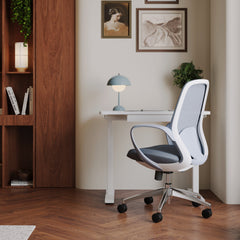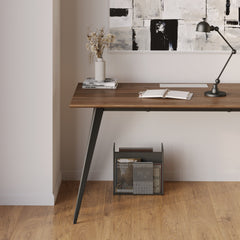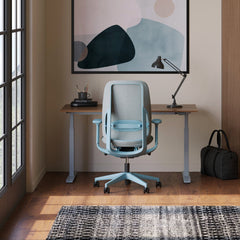Get 10% off your first order
Find the office furniture that’s designed to match your style, comfort, and needs perfectly. Subscribe
Workstations That Evolve with Your Schedule

Visit quiz page to see how we makes it easy to create an inspiring workplace

Minimalism embodies restraint, intention, and harmony. It removes clutter not only from the home but also from the mind. In contemporary interior design, minimalist furniture brings proportion, rhythm, and flow into focus. Chairs in particular become sculptural anchors that express form, texture, and balance through simplicity.
Minimalist chairs are not just about clean lines; they represent the dialogue between function and form. In modern homes where glass, metal, and neutral tones dominate, the right chair can soften rigidity while maintaining architectural precision.
Modern interiors prioritize functionality and structure. Minimalism enhances this by refining each detail. When applied thoughtfully, it merges technology, ergonomics, and craftsmanship. The result is an interior that feels open yet purposeful, simple yet expressive.
Chairs designed under this philosophy integrate seamlessly with modern environments. Whether in a Scandinavian-inspired living room or a Japandi-style studio, the key lies in quiet cohesion—each piece belonging naturally within the space.
A chair’s silhouette influences how people experience a room. Beyond their practical purpose, chairs express a home’s personality and spatial character. The proportions of a seat can echo architectural geometry, reinforce visual flow, and complement other decor elements.
In minimalist spaces, proportions matter as much as materials. Low-profile seating maintains openness in compact areas, while taller backs or curved frames add sculptural depth. This subtle manipulation of shape defines zones without requiring physical dividers.
Even within minimalism, variation in texture adds emotional warmth. Linen upholstery, natural wood grains, or matte metal frames bring tactile balance to smooth walls and polished floors. The Muse accent chair for neutral-toned spaces demonstrates this principle, pairing soft contouring with a calming visual rhythm ideal for understated environments.
Modern interiors thrive on controlled contrast. A minimalist chair can either dissolve into the space or stand as its focal point. The harmony between shape, surface, and tone dictates which approach prevails.
Combining organic curvature with structured geometry keeps modern interiors from feeling sterile. Smooth, shell-like forms break up the repetition of right angles. The Seashell-inspired statement chair captures this dynamic tension, introducing fluid lines that balance architectural precision.
Color within minimalist design rarely shouts—it whispers. Muted palettes of beige, gray, black, and white calm the senses, while natural tones create a sense of authenticity. A single accent chair in a contrasting hue can function as visual punctuation without disturbing balance.
True minimalism values comfort as much as appearance. A minimalist chair should feel effortless to use while remaining visually light. This is where ergonomic innovation meets aesthetic discipline.
Insights from the CDC’s NIOSH division on workplace ergonomics emphasize posture-friendly design as a vital element of daily well-being. Incorporating ergonomic intelligence into minimalist seating ensures comfort remains central to the design philosophy.
| Model | Distinctive Feature | Design Intent |
|---|---|---|
| Novo Line | Dynamic lumbar adjustment and breathable back mesh | Everyday posture support in modern work settings |
| Onyx Series | Sculpted shell with contoured airflow channels | Lightweight comfort for compact interiors |
The Novo ergonomic chair with balanced posture design integrates movement and support without aesthetic heaviness. Its refined silhouette complements the geometry of glass and wood interiors. In contrast, the Onyx ergonomic silhouette chair for creative environments enhances visual interest through its curved seat structure, bringing vitality to minimal studio spaces.
Minimalism rejects excess. By focusing on only what enhances comfort, minimalist chairs encourage physical ease and mental focus. Reduced components lead to cleaner visuals, while high-quality mechanisms remain discreet and purposeful.
Every minimalist chair communicates through its material composition. The grain of wood, the sheen of metal, or the density of molded plastic defines the tone of a room. Authenticity and craftsmanship matter more than ornamentation.
Modern interiors favor materials that look and feel genuine. Matte finishes and organic textures align with natural light and architectural restraint. These details ensure that furniture integrates harmoniously into the built environment.
Sustainability in minimalism transcends trend—it is an ethical standard. Recycled materials and renewable resources like FSC-certified wood demonstrate design consciousness. Simple forms require precision, so construction quality becomes the ultimate marker of value.

| Material | Character | Ideal Use Case |
|---|---|---|
| Natural Oak | Warm, grounded | Scandinavian interiors |
| Brushed Steel | Modern, reflective | Industrial-style spaces |
| Matte Polypropylene | Lightweight, practical | Compact apartments |
| Upholstered Linen | Textured, inviting | Living or reading nooks |
Lighting transforms how minimalist furniture interacts with architecture. The interplay of shadows, reflection, and contour accentuates a chair’s presence.
Directional light highlights structural purity. Soft diffusion, by contrast, enhances warmth and comfort. When placed strategically, minimalist chairs can guide light flow through the space, strengthening compositional harmony.
Spatial rhythm depends on spacing and symmetry. Chairs aligned with architectural lines—windows, columns, or rugs—anchor visual balance. Slight misalignments, intentionally applied, create dynamic tension for a more organic layout.
Functionality defines modern design success. Every chair must earn its place in a home’s rhythm—equally at ease in dining rooms, lounges, and workspaces.
The Urbanica modern desk range exemplifies this philosophy by merging versatile form with ergonomic efficiency. Chairs paired with clean-lined desks reinforce continuity across personal and professional zones.
Consistent materials and forms unify home offices with living areas. Chairs with slim profiles prevent visual disruption while ensuring full ergonomic function. Integrating seating into multifunctional layouts preserves the openness essential to minimalism.
1. Maintain sightlines between desk and natural light sources.
2. Avoid bulky chair bases that interrupt floor patterns.
3. Use neutral finishes to align with wall and shelving tones.
4. Position seating where proportions respect overall spatial geometry.
Creating cohesion across an interior requires thoughtful composition. A minimalist aesthetic does not demand uniformity; rather, it encourages intentional contrast within a shared vocabulary.
Customization tools like the Build Your Bundle customization feature simplify curation, enabling consistent tone and material alignment across different rooms.
To achieve unity, vary form while keeping finishes consistent. For example, curved dining chairs may pair beautifully with angular side chairs if they share color or texture. Introduce subtle accents through textiles or lighting to prevent visual monotony.
Coordinating from the Urbanica designer chair collection allows homeowners to blend sculptural, ergonomic, and decorative pieces without losing aesthetic harmony. When arranged mindfully, diversity reinforces spatial rhythm and depth.
Global design movements shape how minimalism manifests in modern interiors. Understanding their distinctions helps align furniture selection with personal aesthetic values.
Scandinavian minimalism emphasizes warmth through natural textures and light wood. Japandi, its Japanese counterpart, deepens this philosophy with wabi-sabi imperfection and tonal serenity. Both favor balance and craftsmanship, highlighting how simplicity becomes emotional resonance.
Many minimalist chairs trace their lineage to mid-century designers who championed functional beauty. Their principles continue in contemporary pieces that rely on proportion and purity rather than embellishment.
Minimalism is more than an aesthetic—it is a spatial philosophy. The way a chair interacts with architecture determines the user’s experience of balance and flow.
In minimalist interiors, what is absent holds equal importance to what is present. Chairs positioned thoughtfully around negative space create a rhythm that guides movement and visual calm.
Every curve and angle in a well-designed chair follows human proportions. This anthropometric precision ensures that design serves the body first and style second. Chairs that respect this principle contribute to long-term comfort and harmony within the environment.

Minimalist design continues to evolve with changing lifestyles. Flexibility, sustainability, and emotional connection are the defining features of its next chapter.
Future minimalist chairs emphasize adaptability. Pieces that transition between functions—dining, working, lounging—reflect how modern homes evolve with their occupants. Modularity supports sustainable consumption by reducing the need for replacement.
Beyond durability, emotional sustainability ensures furniture remains cherished over time. A well-designed minimalist chair forms part of a personal narrative, blending utility with memory. This connection encourages mindful living and long-term appreciation.
Minimalist chairs shape more than interiors; they shape the experience of space itself. Through restraint, they achieve elegance. Through ergonomics, they achieve comfort. Through craftsmanship, they achieve authenticity. Each chair becomes a quiet declaration that design, when simplified with care, endures far beyond trend.

Workstations That Evolve with Your Schedule

Spaces That Shift With You: Building a Workspace That Adapts to Every Task

Room to Think: Designing an Efficient Workspace Without Overcrowding
Get 10% off your first order
Find the office furniture that’s designed to match your style, comfort, and needs perfectly. Subscribe
Leave a comment